October 18, 2010 – 07:00 am EDT
The market had another great week and QQQQ actually moved to a new high for the year. It is always good to see the NASDAQ 100 ETF leading the market higher so what is the problem? There continues to be a distinct lack of volume behind the second leg of this rally and SMH lagged behind over the last week. These signs are not encouraging but lets take a closer look…
****Thanks to all those who referred people to this newsletter over the last week. The more readers we have the more services we can provide you.
.
ETF % Change Comparison
.

As you can see, SMH was only up 0.42% over the last week despite QQQQ leaping ahead 3.50%. This would not be so concerning were it not for the lack of volume.
Learn more – ETF % Change Comparison
.
![]()
.
A Look at the Charts
.
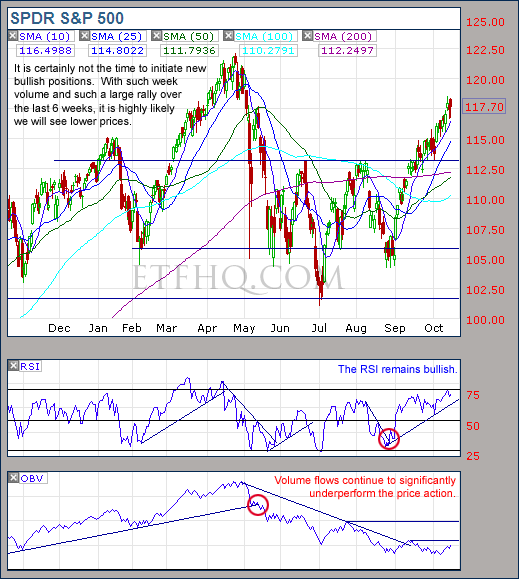
Now is a time to hold and look for excuses to sell. Volume says that this rally is simply unsustainable.
.

QQQQ’s new high, despite looking impressive lacks volume and the backing of the semiconductors.
.
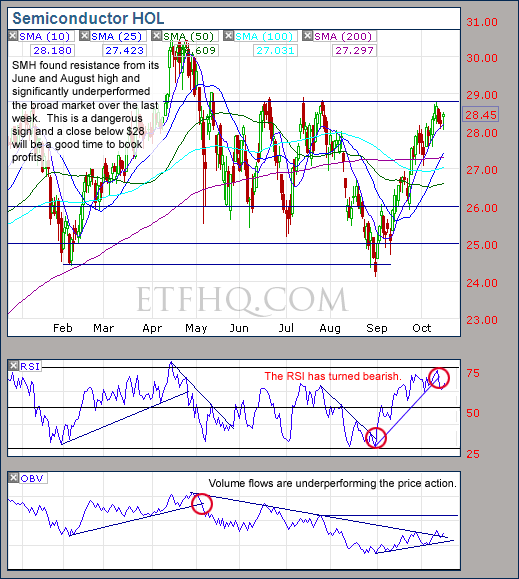
If SMH can close above $29 then I will be very surprised. A close below $28 will be a warning to book profits.
.
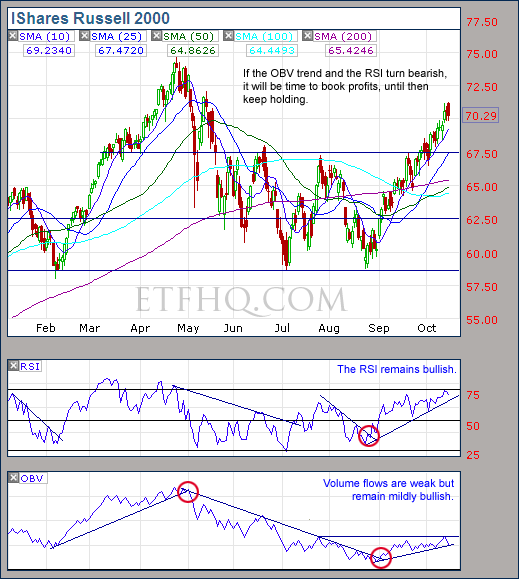
No reasons to jump out of IWM at this point but it wont take much for volume flows to turn bearish.
.
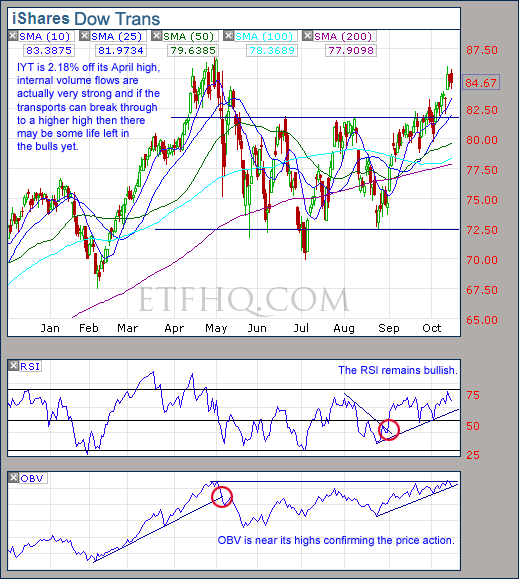
IYT has the best volume flows of the influential ETFs. If it can break through to new highs then this would be a very positive sign.
.
![]()
.
OM3 Weekly Indicator
.

There are no warning signs from the OM3 Indicator, ‘Strong Buy’ signals with ‘Bull Alerts’ persist across the board.
Learn more – The OM3 Indicator
.
![]()
TransDow & NasDow
.

The TransDow is showing a small profit after one week in the Transportation Index. The NasDow indicates that the Dow has just become dominant over the NASDAQ; historically this has signaled increased risk in the market.
.
What the TransDow Readings tell us:
The TransDow measures dominance between the DJ Transportation Index (DJTI) and the Dow Jones Industrial Average (DJIA). In a strong market the more economically sensitive Transportation Index should be dominant over the DJIA.
Historically the DJTI has been dominant over the Dow 45% of the time. The annualized rate of return from the DJTI during this period was 18.47% with the biggest loss for one trade sitting at -13.27%. The annualized return from the DJIA during the periods it was dominant over the DJTI was just 4.06% and the biggest loss for one trade was -16.13%. A 4% stop-loss is applied to all trades adjusting positions only at the end of the week.
What the NasDow Readings tell us:
The NasDow measures dominance between the NASDAQ and the DJIA. Using the same theory behind the Trans Dow; in a strong market the more economically sensitive NASDAQ should be dominant over the DJIA.
Historically the NASDAQ has been dominant over the DJIA 44% of the time. Taking only the trades when the NASDAQ is above its 40 week moving average the annualized rate of return was 25.47% with the biggest loss for one trade sitting at –8.59%. The annualized rate on the DJIA during the periods it was dominant over the NASDAQ is just 8.88% and the biggest loss for one trade was –12.28%. A 8% stop-loss is applied to all trades adjusting positions only at the end of the week.
.
![]()
.
LTMF 80 & Liquid Q
.
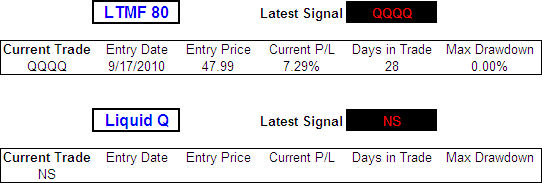
LTMF 80 is showing a tasty little profit on QQQQ after 28 days, lets hope that these profits will remain if we see a pull back.
.
Historical Stats:
.

.
How The LTMF 80 Works
LTMF stands for Long Term Market Forecaster. It reads volume flows relative to price action and looks for out performance of volume measured on a percentage basis over the prior 12 months. During a sustained rally the readings will reach high levels (near 100%) making it imposable for the volume reading to always outperform price so any reading above 80% will maintain the buy signal. This system has outperformed the market over the last 10 years but performance has been damaged by some nasty losses. It only produces buy signals and only for QQQQ.
How Liquid Q Works
Liquid Q completely ignores price action and instead measures the relative flow of money between a selection of economically sensitive and comparatively stable ares of the market. It looks for times when the smart money is confident and and can be seen by through volume investing heavily is more risky areas due to an expectation of expansion. This system has outperformed the market over the last 10 years and remained in cash through most of the major declines. It only produces buy signals and only for QQQQ. We will provide more performance details on the web site for these systems soon.
.
![]()
.
Summary
The rally over the last 7+ weeks has been impressive and the market has made some real ground higher. At this time there are no solid reasons to sell but there are multiple warning signs that the current risk level is very high. Most notably these risks are from a lack of volume almost across the board and more recently a failure by SMH at resistance. Now is certainly not a time to be looking to open new bullish positions but it is a time to look for excuses to lock in profits.
.
Any disputes, questions, queries, comments or theories are most welcome in the comments section below.
.
Cheers
Derry
And the Team @ ETF HQ
“Equipping you to win on Wall St so that you can reach your financial goals.”
.
P.S Like ETFHQ on Facebook – HERE
.
![]()
.
Quote of the Day:
“The eyes of others are the eyes that ruin us. If all but myself were blind, I should want neither fine clothes, fine houses, nor fine furniture.” – Benjamin Franklin